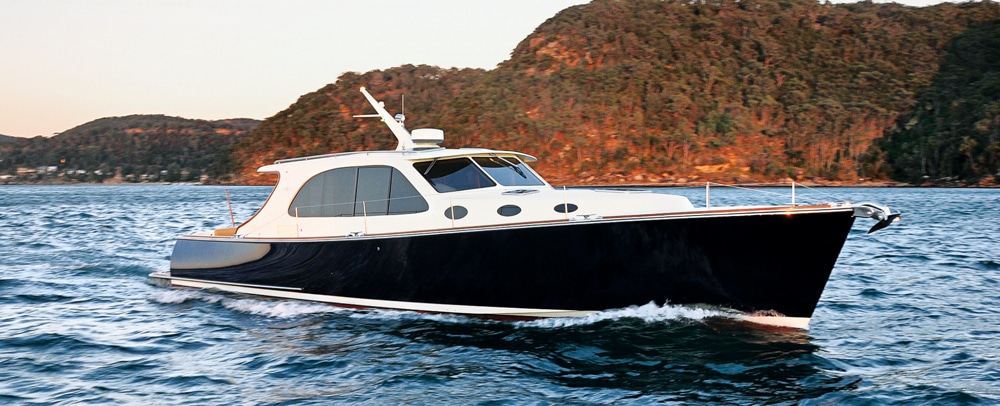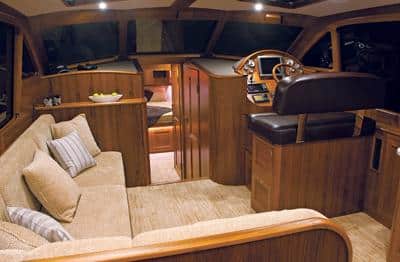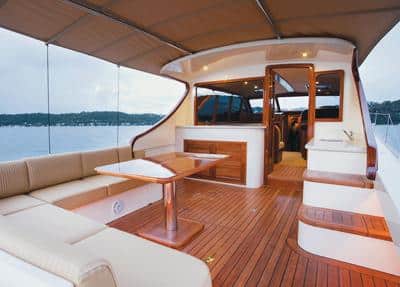
Palm Beach 50
I’ve been courting the Palm Beach 50 for nearly two years. She first began tugging at my heartstrings while docked at the Sanctuary Cove Boat Show on Australia’s Gold Coast, teasing me with her elegant profile and seductive Australian accent. At this early stage of our relationship, I didn’t appreciate all of the flawlessly executed details that builder Mark Richards slaves over. Standing on the dock in the cool autumn air, I was still in the flirting stage, taken by her elegant looks, trying to figure out if we had met before, casting a few winks in her direction.
She possessed some familiar Down East design elements, but employed more contemporary styling cues that blended together to create one of a kind. Hmm, who was she? I had to meet her.
Her profile had a moderate sheer, creating a purposeful appeal. The flare rose subtly to the stem and a fine entry. Moderate tumblehome shaped the transom. And Richards recently altered the deckhouse tooling on the latest 50, extending the forward coach roof slightly and improving her looks even a little more.
I didn’t end up dating the Palm Beach 50 that graces these pages — and will debut at the Newport International Boat Show in September — for another 12 months. Ever the protective father, Richards asked that I take out her sister first. We sea-trialed the 50 that I first saw at the 2009 Sanctuary Cove Boat Show along the Gold Coast, and I was impressed by her quiet, smooth ride. Owner Andy Graig specified twin 480-horsepower Yanmar diesels, which provided a top speed of 32 knots at 3300 rpm.
However, Richards asked that we hold back on the publication of that test until he tweaked the 50 for the North American market. “I just want to make sure we get it right,” he said over the phone. “We only get one chance to make an impression.” Between the time of this first date and my test on the most recent Palm Beach 50, he certainly got it right, producing a zippy, Down East styled cruiser, equally adept as a day boat or for spending a few weeks off the grid.
Richards and his U.S. agent Andy Shoemaker developed an interior layout that works well in my opinion. And the beauty of working with Palm Beach Motor Yachts is the company’s willingness to customize each build to suit an owner’s needs. You want one large master stateroom and the galley down like Mr. Graig’s boat? No problem. How about a guest stateroom with one double instead of bunks? You’ve got it.
Richards began a boatbuilding apprenticeship at 16 and never looked back. In between building and refitting yachts, he became a world-class sailor. He has three America’s Cup campaigns to his credit and, as skipper of the Reichel/ Pugh designed maxi Wild Oats, won a record four consecutive Sydney Hobart races. (Vintner Robert Oatley, whose wines, at this writing, are just entering the U.S. market, owns Wild Oats.) In addition, Richards has been involved in the construction of several high-tech maxis and America’s Cup builds. This experience — where light and strong rule the day — is evident when reviewing the construction methods used on the 50. The hull is built using Core-Cell, E-glass, vinylester epoxy resins and carbon fiber for components such as the rudders. All of this equates to a very light boat, weighing in at approximately 27,500 pounds. Compare this to similarly styled yachts and you’ll see that this is damn light — and, lighter means less horsepower is required, efficiencies are improved, and you have an economical package.
The 50 sticks to the water, running on the full waterline, using a warped planing hull design. The warped sections keep the bow down, and there was no bow rise, at any rpm. I simply applied more throttle and we went faster, with zero change in the running attitude. While testing Andy Graig’s boat, we came into an inlet with a following sea, and all that was required was a finger on the wheel for light adjustments. There was no sense of bow steering; she just tracked like a train.
The 50 I most recently tested, shown on these pages, was equipped with a pair of Volvo IPS 600 pod drives, an easy retrofit since there are no tunnels on the hull. The engines used with the pods are Volvo’s 435 horsepower, six-cylinder, D-6 diesel. Richards was still fine-tuning the boat (it only splashed a few days before our test) and yet we achieved a respectable top speed of 30 knots. However, the real benefit is when you look at her performance at 3000 rpm — less than a 90 percent load — and she is achieving an average speed of 25 knots burning 29.3 gallons per hour total. And it’s a quiet ride, measuring 79 decibels at this speed. Consider that the normal level of conversation (outside of New York) is about 64 decibels.

The helm features easily viewed analog gauges and a 12-inch Garmin 5212 chart plotter and radar combo. The starboard window slides down to allow air in, and as Richards demonstrated, you can pop right out through the large opening onto the wide side decks and run a spring line, a process made easier thanks to five cleats on each side. A hatch above the helmsman brings in additional ventilation.
On the U.S.-bound model, the galley was placed in the after end of the deckhouse to take full advantage of the large and functional cockpit. A window drops down between the galley counter and cockpit, creating one huge, single-level entertaining and dining area. This feature demonstrated another element of the Palm Beach’s winning formula — blending drop-dead gorgeous aesthetics with real cruising functionality. This indoor/outdoor trend is gaining popularity on a variety of designs, but the straightforward, gimmick-free layout of the 50’s large cockpit creates a space that’s tough to beat. A retractable soft top extends from the deckhouse to the transom.
The galley is fully equipped with a two-burner stove, a double stainless-steel sink, a drawer-style microwave, dishwasher, fridge and freezer. In the cockpit there is another fridge and an ice maker. Stowage is plentiful throughout.
Forward of the galley is one of the most comfortable settees I’ve experienced in some time. Lying down with the Sunday paper and taking a little nap while tugging at the anchor in a secluded cove will be a must. Walking through the 50, I found myself sliding my hand across the satin-finished teak joinery. There were no blemishes of any sort, and the blending of the grain was well executed.
Belowdecks, the portside stateroom has twin bunks, and a wet head is opposite. The master stateroom is forward and benefits from a lot of sole, allowing two people to easily get dressed at the same time. The hexagon-shaped berth widens at the foot, and a head with a shower stall is on the starboard side.

One aspect of the Palm Beach 50 that may make her the most popular girl in town is the relatively reasonable price, when compared with boats of the same quality level and style. The base price of the 50 with the IPS package is $1,495,400, and the spec sheet is comprehensive. Palm Beach also offers the 50 with a flying bridge, and additional models include a 38, 45, 55 and a 65, which we’re running this fall. More boats to tug at even more heartstrings. But be careful; only flirt with this one if you’re looking for a long-term relationship.
Specifications
LOA: 55’0″
Beam: 14’6″
Draft: 3’0″
Displ.: 27,500 lb.
Fuel: 425 gal.
Water: 185 gal.
Engine Options: Several packages available
Engines Tested: 2 x 435 hp Volvo IPS 600 diesels
Base Price: $1,495,400
Palm Beach Motor Yachts, +61 024389-1244; pbmy.com.au
Ballast Point Yachts, 619-222-3620; ballastpointyachts.com









